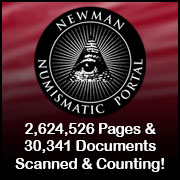
About UsThe Numismatic Bibliomania Society is a non-profit association devoted to the study and enjoyment of numismatic literature. For more information please see our web site at coinbooks.org SubscriptionsThose wishing to become new E-Sylum subscribers (or wishing to Unsubscribe) can go to the following web page link MembershipThere is a membership application available on the web site Membership Application To join, print the application and return it with your check to the address printed on the application. Print/Digital membership is $40 to addresses in the U.S., and $60 elsewhere. A digital-only membership is available for $25. For those without web access, write to: Charles Heck, Treasurer
AsylumFor Asylum mailing address changes and other membership questions, contact Chuck at this email address: treasurer@coinbooks.org SubmissionsTo submit items for publication in The E-Sylum, write to the Editor at this address: whomren@gmail.com BUY THE BOOK BEFORE THE COIN |
- WAYNE'S WORDS: THE E-SYLUM SEPTEMBER 25, 2019
- NEW BOOK: GIRL ON THE SILVER DOLLAR
- NEW BOOK: FAO COINS INTERNATIONAL CATALOG
- BARNES & NOBLE TO SELL "THE NUMISMATIST"
- DAVE PERKINS ON THE INVASION OF CHAMPAIGN
- NEWMAN PORTAL ADDS PITT FARTHING CENSUS
- FUTURE OF NUMISMATICS: JOHN FEIGENBAUM
- BURDETTE TO SPEAK AT VIRGINIA SHOW
- QUERY: OCTAGONAL LARGE CENT INFORMATION SOUGHT
- NOTES FROM E-SYLUM READERS: SEPTEMBER 22, 2019
- AMERICAN MEDALISTS IN PARIS
- THE NATIONAL BANK OF BELGIUM MUSEUM
- VOCABULARY: ESSAY, TRIAL AND EXPERIMENTAL PIECES
- CHARLES LEOPOLD PODHAISKI (1854-1913)
- CHICAGO HALL OF FAME INDUCTS ARLIE SLABAUGH
- HARVEY STACK'S NUMISMATIC FAMILY, PART 53
- ANS 2020 GALA HONOREE RICHARD M. BELESON
- ROBINSON 110TH AUCTION SELECTIONS
- SELECTIONS FROM HOLABIRD OCTOBER 5, 2019 SALE
- ARCHIVES INTERNATIONAL SALE 55 ANNOUNCED
- WAYNE'S NUMISMATIC DIARY: SEPTEMBER 22, 2019
- THE INFAMOUS "NE" PINE TREE SHILLING
- HISTORY OF CURRENCY COUNTERFEITING
- THE JOE REDNER POLITICAL NOTE
- LOOSE CHANGE: SEPTEMBER 22, 2019
- FEATURED WEB SITE: CANADIAN ASSOCIATION FOR NUMISMATIC EDUCATION
Click here to access the complete archive
To comment or submit articles, reply to whomren@gmail.com
Content presented in The E-Sylum is not necessarily researched or independently fact-checked, and views expressed do not necessarily represent those of the Numismatic Bibliomania Society.
WAYNE'S WORDS: THE E-SYLUM SEPTEMBER 25, 2019
 This week we open with two new books, a new
retail outlet for The Numismatist, the Invasion of Champaign, updates from the Newman Numismatic Portal, numismatic speakers, and an eight-sided Large Cent.
This week we open with two new books, a new
retail outlet for The Numismatist, the Invasion of Champaign, updates from the Newman Numismatic Portal, numismatic speakers, and an eight-sided Large Cent.
Other topics this week include the National Bank of Belgium Museum, essay, trial and experimental pieces, C. L. Podhaiski, Arlie Slabaugh, Richard Beleson, auction selections and previews, and the history of counterfeiting.
To learn more about the Girl on the Silver Dollar, FAO coins, the June 25-27, 1890 Parmelee Sale, Pitt Farthings, the International Banking Corporation, the Newark Whaling, Sealing & Manufacturing Co., Old Dan Tucker, the "NE" Pine Tree shilling, the School for Coin and Medal Designing and Die Cutting, the Case of the Coin-Collecting Cop Named Crooks, and glorified jam labels, read on. Have a great week, everyone!
Wayne Homren
Editor, The E-Sylum
NEW BOOK: GIRL ON THE SILVER DOLLAR
Roger Burdette's new book, Girl on the Silver Dollar has been published. Here's the press release. -Editor
of the long anticipated book Girl on the Silver Dollar,
by Roger W. Burdette.
 It was a time when any
female who modeled for an artist was lumped with immoral and fallen women. The public morality enjoyed praise for allegorical female figures in painting, architecture and
sculpture, but heaped collective scorn if the same creation was identified as a specific woman. Anna W. Williams, known to her friends as “Nannie,” was caught in this hypocritical
morality. She left no written expression of its emotional effects, but we know that she and her friends denied the accusations. To do anything else would have meant personal
humiliation and ruin.
It was a time when any
female who modeled for an artist was lumped with immoral and fallen women. The public morality enjoyed praise for allegorical female figures in painting, architecture and
sculpture, but heaped collective scorn if the same creation was identified as a specific woman. Anna W. Williams, known to her friends as “Nannie,” was caught in this hypocritical
morality. She left no written expression of its emotional effects, but we know that she and her friends denied the accusations. To do anything else would have meant personal
humiliation and ruin.
Within a year of the first release of George Morgan’s silver dollar design in 1878, Philadelphia newspapers were speculating about identity of the woman who posed for the Liberty portrait. Speculative reports were that a local woman, Anna W. Williams, had modeled for Morgan and it was her profile depicted on the new coin. Reporters interviewed Miss Williams and some of her friends, but could find no definitive answer – so they invented stories based on a few scarce facts. Curiously, one newspaper, at the close of a lengthy article, admitted that the dollar’s Miss Liberty did not resemble Miss Williams, but looked more like Morgan’s wife.
But such little touches of reality never deterred speculative “truth.” Until the time of her death in 1926, Anna Williams was followed by a plague of tall tales, and innuendo that left little doubt that she had compromised her feminine morals and modeled for an artist.
Roger W. Burdette’s latest research book, Girl on the Silver Dollar, is a search for truth after over 140 years of confusion. More than a decade of patient research, investigation and validation have produced a meaningful story of real people, behaving as people do in their daily lives. That Nannie modeled for George Morgan in October 1876, just weeks after he landed in America, is clearly established. A contemporary portrait titled “Anna W. Williams” was created by Philadelphia realist painter Thomas Eakins and his future wife Susan McDonald – exactly as described by one of Nannie’s friends. Morgan’s sketch book includes untitled pencil drawings that match Nannie’s features. An engraved illustration in Harper’s Monthly Magazine from 15 years later shows Nannie older but with the same distinctive features.
Yet, none of her features resemble any part of the 1878 silver dollar Liberty portrait.
Along with images of Anna’s other modeling work, Burdette presents details of her career as teacher, advocate and later Supervisor of Kindergartens in Philadelphia’s early childhood education system.
But Girl on the Silver Dollar is more than about Anna Williams. A separate chapter chronicles the development of a new “standard silver dollar” to replace the one eliminated by the Coinage Act of 1873. Here we find Mint Director Linderman on the verge of accepting William Barber’s new Liberty portrait (often called the “Sailor Head” by pattern collectors), only to suspend work when Morgan arrived from London. Copious pattern piece photos, descriptions and quotations bring the reader into behind-the-public-scene discussion and controversy.
Controversy is also a theme in the following chapter dedicated to uncovering the truth behind elusive 1895-P silver dollars struck for circulation. Long in demand by coin collectors, none of the 12,000 pieces struck for circulation have ever been identified. This forced collectors to include an 1895 proof dollar in their cabinets and albums to fill that gaping hole. Normal Philadelphia Mint operations suggest the twelve bags of circulation dollars were placed in a crowded vault, then transferred to the new Philadelphia Mint sometime between 1899 and 1901. Some authors have speculated that the 1895 coins were actually dated “1894” even when ample evidence argues otherwise. The most common explanation is that all 1895 circulation dollars were indiscriminately melted during the rush to convert coins into bullion for sale to Great Britain in 1918.
The final chapter of Girl on the Silver Dollar brings us to the original and implementation of the Pittman Act of 1918. This urgently passed Act of Congress caused nearly half of all existing U.S. silver dollars to be converted into bullion and sold to Great Britain to help stabilize the economy in India during World War I. Although we know the number of silver dollars destroyed, no records were kept of coin dates or mints. Thus, a great anonymous hoard was destroyed and an equally anonymous hoard remained in Treasury vaults until the great silver dollar distribution of 1963-64. (See Burdette’s early 2019 book release, Private Pattern and Related Pieces: International Nickel & Gould Incorporated, for details about the run of Treasury silver dollars.)
Together, Girl on the Silver Dollar is a feast for the eyes and minds of coin collectors everywhere. Every owner of a Morgan silver dollar who has wondered about the origin of this beloved, if somewhat stuffy Liberty portrait, will find new revelations. Ideas and facts not only about the coin but about the people who designed and manufactured these silver dollars are found on every page. We can see the coins piling in unwanted masses, shuttled from vault to vault, and eventually used as war-time tools for the Allied victory.
Available from Wizard Coin Supply. The cover price for the 8-1/2 x 11-inch, 135 pages, hard cover, full color – $24.95.
For more information, or to order, see:
Girl on the Silver Dollar (https://www.wizardcoinsupply.com/girl-on-the-silver-dollar)
Here are some early reader reactions. Thanks! -Editor
Dave Lange writes:
I ordered Roger Burdette's book Girl on the Silver Dollar, and it arrived today. This is the true story of Anna Williams who, reportedly, was the model for Liberty on George T. Morgan's 1878 silver dollar.
Roger clarifies this and several other matters in a thoroughly researched and beautifully illustrated book. It includes a comprehensive account of the 1918 Pittman Act that led to the destruction of 300+ million silver dollars and their eventual replacement during 1921-28.
This hard-covered book is a high quality product. I contacted Roger about ordering it directly from him (as a fellow book author I know all about eBay and PayPal fees eating into one's rewards). He informed me that the only source is Wizard Coin Supply. I highly recommend acquiring this title, and be sure to ask for a signed copy while they last.
Tom Kays writes:
The design on the obverse of the Morgan dollar is familiar to us all, but does that American beauty, “Miss Liberty” resemble certain living models, used by the artist? Can we name the model such as Elsie Stevens on the 1916, Winged Liberty (Mercury) Dime or Doris Doscher on the controversial 1916 quarter designed by Weinman?
George T. Morgan began his career influenced by “Marianne” of France and Roger explores art and current events during, and after the 1876 Centennial Exposition in Philadelphia that gave rise to competing coin designs, including the one we all know.
Women who posed for artists risked their reputations and caused uproar in their domestic lives, so it takes a skilled researcher to read between the lines of the gossip pages to figure out the true identity of who posed, and what really happened. Some see the face of Morgan’s wife, Alice, as the model. Others look to the mysterious Miss Anna Williams of the Girl’s Department at the House of Refuge. Are they classic Greek beauties of antiquity or mere school girls in George T. Morgan’s sketchbook?
Pattern coins and specimen dollars of 1877 shown to President Hayes ‘went off like hot cakes’ in a competition between designers including William Barber, Anthony Paquet, and George T Morgan. The winner had quite a run for the money. Upon first receipt of new Morgan dollars, The Daily Nevada Tribune says: “We have examined the coin critically, and from an artistic point of view are inclined to conclude that the designer of it either had a vindictive spite against the American people, or was a green hand at the business. The picture of Liberty, on one side, reminds us of Dr. Mary Walker’s photograph taken on the rough side of a stove lid, at a moment when the old girl was suffering from too much green fruit…[the eagle] looks far more like a bat hung up to dry…the new silver dollar…caused…much ridicule at the hands of people all over the country.”
NEW BOOK: FAO COINS INTERNATIONAL CATALOG
Jon Radel alerted me to the existence of this 2017 book on FAO coins - these were organized by the United Nations Food and Agriculture Organization and issued by 119 countries. Thanks. It's available on eBay, but I'm not sure if there are other outlets carrying it. Here's the description from the author's listing; he's selling them direct. -Editor
 All in color, high quality pictures -
new edition revised and up to dated of the FAO coins catalogue minted by 119 nations for the fao, arranged by nation,year, metal, mintage,types, variants and patterns since 1968.
It includes an evaluation of the market value of every single coin (total: over 1750) in three degrees of maintenance. This one is a specialized FAO coins catalogue - pages 394
(20 pages more of the last edition) all in colour including panels, albums and proof commemorative sets; a4 size, hand luxury resistent binding, around 1700 pictures, obverse and
reverse, diameter, size, quantity, mint town, rarity grade and actually market value. For each nation, coat of arms, flag, geographical location-demographic and historical facts
and informations about the activity that the FAO has initiated in these countries both before and during FAO coins plan period. It is a must in the numismatic thematic modern
coins catalogue. Limited edition.
All in color, high quality pictures -
new edition revised and up to dated of the FAO coins catalogue minted by 119 nations for the fao, arranged by nation,year, metal, mintage,types, variants and patterns since 1968.
It includes an evaluation of the market value of every single coin (total: over 1750) in three degrees of maintenance. This one is a specialized FAO coins catalogue - pages 394
(20 pages more of the last edition) all in colour including panels, albums and proof commemorative sets; a4 size, hand luxury resistent binding, around 1700 pictures, obverse and
reverse, diameter, size, quantity, mint town, rarity grade and actually market value. For each nation, coat of arms, flag, geographical location-demographic and historical facts
and informations about the activity that the FAO has initiated in these countries both before and during FAO coins plan period. It is a must in the numismatic thematic modern
coins catalogue. Limited edition.
The weight is 1,5 Kilo
Shipping cost in registered: to Europe 32,00 US dollars- TO USA and others nations 39,00 US dollars (I pay more).
For more information, or to order, see:
FAO COINS INTERNATIONAL CATALOG - LAST EDITION FULL
COLOR + 6 F.A.O. COINS GIFT (https://www.ebay.com/itm/FAO-COINS-INTERNATIONAL-CATALOG-LAST-EDITION-FULL-COLOR-6-F-A-O-COINS-GIFT-/123099690520)
Jon adds:
As is the case in writing most any catalog of modern world coins, you have to contend with all, or at least most, of the coins in your catalog already being widely published in the Standard Catalog of World Coins (SCWC). So how does Attilio Armiento add value beyond that? With higher quality photos. With entire types, or variants, which aren't mentioned in SCWC (I've not actually independently confirmed this--but the author carefully cross-references KM numbers and notes which coins aren't listed). With some additional information on mints, mint marks, and rarity in the retail marketplace. And, probably of greatest value, by producing a very attractive catalog focused on a single, international series of coins which, despite being fairly widely collected best I can tell, really has no other current, comprehensive catalog.
Of even greater interest to me personally, is the chapter of the catalog after all the individual coins are listed: A comprehensive listing, complete with useful photographs, of the various display panels and albums that the FAO sold to house the coins. While not really a dark secret, until I found this catalog, I was having trouble tracking down a comprehensive listing of the various items.
I will note that, while there is some background information on the program and history of the FAO, this is almost exclusively a catalog, in the sense of a listing of items, only. I would have appreciated more information on the genesis and progress of the now-ended program. Information on the marketing material and advertising used by the FAO would have added interesting information on the approach of the FAO in marketing to collectors starting in 1968 (assuming that even started at the very beginning...something else I'm curious about). A bit of information on the ephemera associated with the sales of albums would be interesting. For example, I know that at least the early albums came with printed sheets with information on the individual coins, but those don't appear to be mentioned anywhere in this book.
I've already asked the author if he knows of any catalog of the multiple series of medals that the FAO has issued over the years. He said that's he's working on that collection; I hope it eventually results in a catalog of this quality. I'd certainly buy a copy.
Thanks Jon, for the great review. -Editor

BARNES & NOBLE TO SELL "THE NUMISMATIST"
The ANA is making a push to market their monthly publication The Numismatist in Barnes & Noble bookstore nationwide. Great idea! -Editor
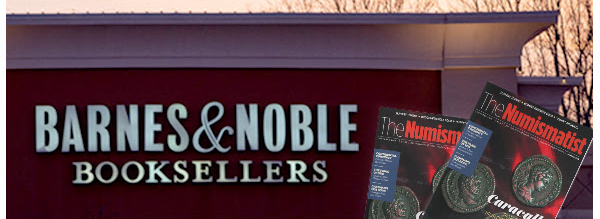
Numismatists soon will be able to pick up their favorite collecting magazine while browsing the "Hobbies" section of Barnes & Noble. Starting Oct. 1, The Numismatist will be available at the retail store. "Our goal is to broaden our audience and increase awareness of the numismatic hobby," said Editor-in-Chief Barbara Gregory.
The American Numismatic Association has agreed to test-market The Numismatist, now in its 132nd year, at 600+ Barnes & Noble stores around the country for a six-month period. Look for the magazine at your local Barnes & Noble on the special promotional "end cap" displays!
DAVE PERKINS ON THE INVASION OF CHAMPAIGN
Board member Dave Perkins published an account of his visit with NBS to Dan Hamelberg's library last month in the September 15, 2019 issue of the JR Newsletter, an electronic publication of the John Reich Collectors Society. With permission, here it is. -Editor
Prior to this year’s ANA Convention, fellow collector and JRCS member Mike Clark and I signed up for a visit to Dan Hamelberg’s Library and home. This visit was scheduled for the Sunday after the annual ANA Convention in Chicago.
While we went primarily for the Numismatic content, we were pleasantly surprised to see historical items from the early United States including rare maps, manuscripts, autographs, coin art and coin glass, baseball memorabilia and many other items in this extensive collection.
Click on the link below to see a short video of what is termed” The Invasion of Champaign.” Imagine a library collection with over 13,000 Numismatic auction catalogs that would cover five football fields of linear space! Or one favorite of mine, a plate photo from the June 25-27, 1890 Parmelee Sale together with two of the actual coins plated, the 1796 15 Stars and 16 Stars Half Dollars in PCGS AU55 and PCGS XF45 respectively! These are both “First Year of Issue” coins that Dan also collects.

How about a neat coin clock made out of 1878 dated Liberty Seated Dollars, Half Dollars, Quarters and Dimes. Or the inventory (book) of the Col. E.H.R. Green coin collection, prepared by F.C.C. Boyd (of World’s Greatest Collection fame). And an original Revolutionary War map of Boston.
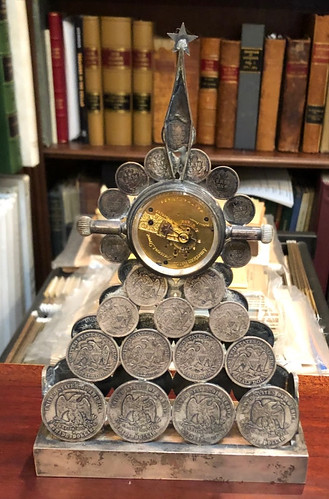
Warning, you may want to periodically pause the video in order to study all the items visible in the video background.
https://nnp.wustl.edu/library/book/567853
Needless to say, it was quite a day!
To read the earlier E-Sylum articles, see:
INVASION OF CHAMPAIGN VIDEO ON NEWMAN PORTAL (https://www.coinbooks.org/v22/esylum_v22n34a10.html)
WAYNE'S 2019 ANA DIARY: PART II (https://www.coinbooks.org/v22/esylum_v22n34a20.html)
NEWMAN PORTAL ADDS PITT FARTHING CENSUS
The latest addition to the Newman Numismatic Portal is a census of Pitt Farthings. Project Coordinator Len Augsburger provided the following report. -Editor

Christopher McDowell Publishes Census of Pitt Farthings
The Pitt tokens are yet another enigmatic entry in the American colonial coin catalog. Nothing is known of their manufacture, which might have occurred in England or in America, nor is the engraver known. What is certain is that they commemorative William Pitt’s involvement in the repeal of the Stamp Act (1766). The Act required a stamp on every official document in the colonies, the proceeds of which were intended to support a standing British army in America, whose primary duty would be of course to enforce the collection of even more taxes from the colonists. The Act was repealed in 1766 due to the influence of William Pitt and others, including Benjamin Franklin.
With little in the way of a documentary record, the pieces themselves tell the story. They were issued in two sizes, historically referred to as “farthings” or “halfpennies” even though no coining authority has been identified. They did circulate in the colonies, and have been found by detectorists. The small format “farthing” pieces are substantially more scarce than the large format “halfpenny,” with values in Fine-12 of $15,000 and $1,200, respectively. Under sponsorship of the Eric P. Newman Numismatic Education Society, Chris McDowell has prepared a census of all 24 known examples of the Pitt farthing. With such a low population, detailed investigation into each example is greatly facilitated, and McDowell’s paper will be the last word on the subject absent the discovery of a hoard.
One of the more interesting pieces is the Anton brass specimen, said to include presidents Rutherford B. Hayes and Lyndon Johnson in its provenance. It was offered by Bill Anton, Jr. in the February 2005 Numismatist and there described as gem uncirculated. Anton corresponded with Eric P. Newman regarding this piece in 1971, forwarding X-rays that Newman used to verify the absence of a casting port. McDowell was able to track down images for this piece, and for all others, except in a single case. With the images, this paper will serve as the “go to” guide for anyone wishing to acquire or catalog an example.
Image: Pitt farthing, ex. John J. Ford, Jr. VII (Stack’s 1/2019), lot 137, realized $43,125.
Link to Pitt Farthing census on Newman Portal:
https://nnp.wustl.edu/library/book/569217
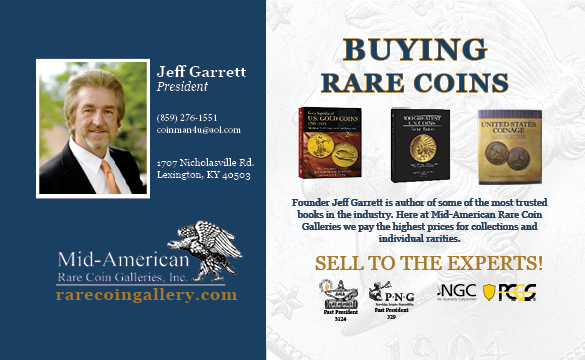
FUTURE OF NUMISMATICS: JOHN FEIGENBAUM
These are selections from the David Lisot Video Library that feature news and personalities from the world of coin collecting. David has been attending coin conventions since
1972 and began videotaping in 1985. The Newman Numismatic Portal now lists all David’s videos on their website at:
https://nnp.wustl.edu/library/multimediadetail/522852
Here's one from the ANA Future of Numismatics Symposium. -Editor
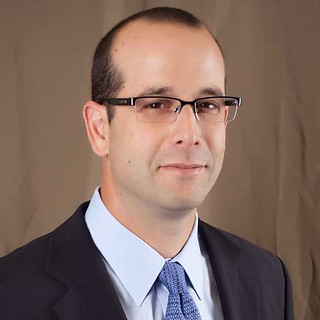 Future of Numismatics Symposium: John
Feigenbaum
Future of Numismatics Symposium: John
Feigenbaum
An excerpt of the video is available for viewing on the Coin Television YouTube Channel at:
https://youtu.be/30Eq0MxeOfA
Donn Pearlman, Moderator, David Lisot, Video Producer, CoinTelevision.com. At the 2019 World’s Fair of Money the American Numismatic Association asked some of the coin industry’s most influential leaders about what they believe is in store for the future of the hobby. Hear these titans of numismatics share what they believe the future holds.
BURDETTE TO SPEAK AT VIRGINIA SHOW
Author Roger Burdette will be speaking next weekend to the Virginia Numismatic Association. -Editor
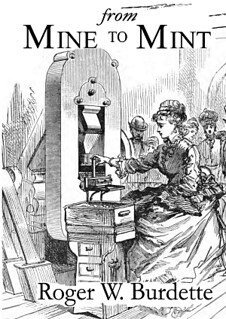 Numismatic author Roger W. Burdette will be
the featured speaker at the Virginia Numismatic Association dinner on September 28, 2019 in Fredericksburg, VA. His subject is based on the award winning book, From Mine to
Mint. Technology and Operations of American Coinage.
Numismatic author Roger W. Burdette will be
the featured speaker at the Virginia Numismatic Association dinner on September 28, 2019 in Fredericksburg, VA. His subject is based on the award winning book, From Mine to
Mint. Technology and Operations of American Coinage.
From Mine to Mint is about technology and methodology of our mints as they changed over time. Mr. Burdette will discuss these aspects of coinage through the perspective of the sources of power (energy) available to our mints.
All coins, medals, tokens paper currency and other things we collect are products of manufacturing processes. The U.S. Mints, like other factories, manufacture coins and medals using current technology – equipment, power sources, technology, metallurgy and available methodologies.
The power to manufacture coins and medals can be grouped into three distinct sources: muscle, steam engine, and electricity.
Muscle Age (not a magazine for body builders)
In its early phase, for approximately 40 years, the Philadelphia Mint was dependent on muscle power – the muscle of men to move the broad arms of a fly press – the muscle of
horses to move a turnstile connected to iron rollers for flattening gold and silver, and turning cutting lathes.
Steam Age
The middle phase, from 1815 when a 10-horsepower steam engine replaced horses in powering the rolling mills, began in earnest only in 1836. Franklin Peale returned from an
extensive research trip to Europe and designed minting equipment to run on fire, water, steam to move wheezing pistons and drive long leather power belts.
Electric Age
The last energy change was by far the most profound. Electric power brought many improvements in mint operations. These included such obvious things as ability to easily add
equipment and reduced floor space needed for presses, and greater consistency of product. Among less self-evident changes greatly improved furnaces, elimination of coal and gas
for most melting and annealing operations, automation of planchet weight sorting, improved employee safety through elimination of open flywheels, gradual Treasury improvement in
distribution with greater emphasis on commercial need. Refining became a simpler, much higher quality operation through electrolytic cells instead of boiling acids.
For more information on the Virginia Numismatic Association show, see:
http://www.vnaonline.org/
QUERY: OCTAGONAL LARGE CENT INFORMATION SOUGHT

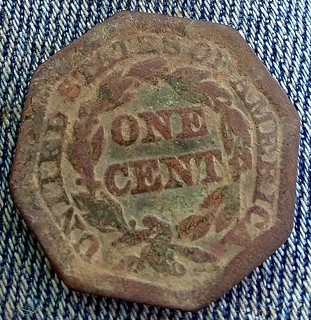
Web site visitor Tony Payne writes:
I'm a 100% disabled veteran turned professional metal detectorist. Last summer my friend and I drove 90 minutes north to Lancaster Ohio to detect an original 1860 house underground railroad house. I walked up in the yard, set my detector down where I always start, right side of the walk before the stairs to enter the residence because most people are right handed and this is about the spot where most people pull a key out of their right pocket dropping coins. This method has paid off more times than I can count.
This particular time as I turned in my Whites Mx Sport pro detector it began beeping as I was purring in the headphones. 4" under the dense soil I dug this 1847 octagonal Large cent. I've been researching this coin for over a year and have found many examples of different years found all over the country. I've seen maybe 15 total online. The only story I have found was that it was called a trust token, a symbol or proof that the bearer was a legitimate slave and not a southern slave spy. I guess it would be presented to the person(s) running the UGRR house to prove yes, they came from another UGRR establishment in line with their dangerous journey.
This coin is the most interesting and mysterious object out of all the items and coins I've dug since I began two years ago. Since the U.S. Mint did not mint octagonal large cents I've been on this quest to substantiate the UGRR trust token story or uncover the true history of this practice. I appreciate any kind of help or advice you could give me. Thank you.
Interesting story, but what is really known about such pieces? I've not encountered one before. Searches of the Newman Numismatic Portal and the general web came up empty. I next reached out to a couple of our knowledgeable readers. -Editor
Dave Schenkman writes:
I think I have one of those somewhere, but I know nothing about them. I assumed they were merely the result of someone with too much time on his hands. I believe I also have one made in the shape of a gear.
Bill Eckberg writes:
I’ve seen couple of these before, but I’ve heard nothing about a purpose. The Underground Railroad would be an interesting story, but I’ve heard nothing about that myself. It’s kind of interesting that the coin shows a reverse rotation.
Cents modified for use as hardware such as washers and gears are common and easily explained. Love tokens and other modified coins have a decorative use, and maybe this one falls into that category. It's clearly been dug, but is it even an actual Large Cent?
Fanciful backstories are a dime a dozen. Is there any proof waiting to be found? Can any of our readers help with this? Thanks. I'd like to learn what websites have images of these along with such a story. -Editor

NOTES FROM E-SYLUM READERS: SEPTEMBER 22, 2019
When $2 Bills Were Last Printed
Paul Peelle of Amherst, MA writes:
The "$2 bill guy" (kid, really) lives about half a dozen miles away from me, and I wrote a letter to the editor right after his story was published. Below is my response.
 I very much enjoyed the Saturday 24 August
article about “the $2 bill guy.” I am extremely pleased that there is someone else as committed to twos as I am.
I very much enjoyed the Saturday 24 August
article about “the $2 bill guy.” I am extremely pleased that there is someone else as committed to twos as I am.
In 1976, the $2 bill was significantly redesigned for the bicentennial with John Trumbull’s painting depicting the presentation of the draft of the Declaration of Independence to the Continental Congress.
I have not spent a one dollar bill since 1976, exchanging them at the bank for twos. Of course, like Robert, I have many personal stories of interesting interactions with people regarding my use of $2 bills, both positive and negative.
I feel obligated to make adjustments to the part of the article that references the U.S. Treasury website, which is woefully out of date. More current information can be found at the U.S. Bureau of Engraving and Printing website. But first, allow me to point out that, unlike coins, the date on bills is not the date of issue, but rather identifies which Series it is. The Series will change whenever the Treasurer of the United States and/or the Secretary of the Treasury changes. Recently, we have had Series 2006, 2009, 2013, and (currently) Series 2017.
The correction is that 2003 was definitely not the last year that $2 bills were printed. November 2018 was the most recent printing of twos (as part of Series 2013), with 3 previous printings in 2018 alone.
Thank you for putting this interesting article about Robert Nehring on the front page.
Thanks! Quite correct. I stopped in a bank branch Friday afternoon and the teller only had two twos between them. I spent one as part of a restaurant tip, and have the other in my wallet. -Editor
To read the earlier E-Sylum article, see:
CALL HIM THE $2 BILL GUY (https://www.coinbooks.org/v22/esylum_v22n36a27.html)
AMERICAN MEDALISTS IN PARIS
Last week we announced three fall 2019 exhibits at Mashiko's Medialia Gallery in New York. One of them is "American Medalists in Paris", curated by Scott Miller from the collections of Jay Galst, Scott Miller, Ira Rezak, David Simpson, Donald Scarinci, and Frederic Withington. Scott kindly forwarded the Introduction from the exhibit catalog. Thanks! -Editor

1895 Susie Pratt Kennedy medal by Frederick MacMonnies
Since the early days of the Republic, American artists generally traveled to Europe for formal training. Until the mid nineteenth century, England and Italy were their countries of choice, with American artists often remaining as expatriates.
Under Napoleon III’s Second Empire, France replaced Italy as the art center of Europe. As Americans began to travel to France, so did American artists. The rise of Paris as an artistic center coincided with a resurgence of interest in medallic creativity, both esthetically and technically. Long the domain of artisans who engraved images directly into steel, sculptors occasionally created medallions using traditional modeling techniques. The most notable of these was Pierre-Jean David, known as David D’Angers, who created a series of nearly 500 portrait medallions of contemporaries. It was the introduction of the pantographic reducing machine in the early 19th century that enabled any trained sculptor to produce a struck medal. However, it was not until the latter part of the century that such machines became sufficiently reliable and available for regular use. The popularity of medals also benefitted from changes in artistic style, beginning with the innovations introduced by Hubert Ponscarme, that led medals away from the standard, centered obverse portrait. Other factors included stronger economies and a better educated population, which more broadly supported leisure activities, such as the collection of artistic, scientific and decorative objects.
By the time the United States celebrated its centennial of independence in 1876, medals were still almost exclusively the work of artisan engravers. However, several American sculptors, such as Olin Levi Warner and Augustus Saint-Gaudens had already gone to France to study and were returning to work in this country. Over the next forty years Americans continued to enroll in French art schools and work with established sculptors and medalists. They eventually started their own studios and helped to found what can be described as an American School of Medallic Art, reflecting the influence of French medalists, but emphasizing American interests and culture, such as American history, industrial and civic achievements, idealized, farm fresh portraiture, and native, Indian culture. The first sculptor to spread the knowledge learned in France was Augustus Saint-Gaudens, whose students constituted a large number of prominent medallic artists in the United States.
Besides the many studio assistants employed by Saint-Gaudens over the years, the Cornish Art Colony attracted some of the major, and sometimes minor artists of the period leading up to World War I. Although Augustus Saint-Gaudens remained the most widely known and influential member, sculptors Daniel Chester French, Laura Gardin Fraser, Frances Grimes, and Paul Manship were also associated with the colony, as were the dancer Isadora Duncan, and artists Maxfield Parrish and Kenyon Cox; even actress Ethel Barrymore came to Cornish in 1906. The many leading figures in the arts present at the Cornish Colony contributed towards an exchange of ideas and approaches that shaped American art for years to come.
As is almost always the case with change, and a modernization of technology, there was a mixture of praise and criticism for the new approach to medallic art. Those with a more traditional view, and these seem mostly to have been German, decried the new methods, claiming that the reducing machine led to a loss of detail that resulted from a failure to execute the design in a 1:1 scale. Other, more traditional engravers, undoubtedly saw a threat to their livelihood, which may help account for the often cited animosity between United States Mint engravers and private sculptors commissioned to design coins. To be fair, however, while sculptors usually had greater artistic ability, their lack of technical expertise often created almost insurmountable problems in the minting of coins, but a drawback of lesser concern in the production of artistic medals.
Despite the grumbling from mint engravers, most artists and collectors embraced the new techniques, which allowed greater freedom for medal designers. Rather than being trained as die engravers, medalists were now, typically sculptors, trained in modeling. This brought new ideas to the medal world. Beginning in Europe, the traditional concept of medals as something commemorative expanded to include objects that were purely aesthetic and better reflected current design. Along with the change in medal production, came the organization of art medal societies, which encouraged both the production and collecting of the newer medallic forms.
In the United States, the new production techniques and a growing interest in art resulted in the dawning of a golden age of medals. Confident in the nation’s growing economic and political strength and able to utilize the services of trained sculptors, wealthy individuals, companies, institutions, and local governments commissioned medals for every conceivable reason.


LEFT: 1915 Rosemary Hall 25th Anniversary medal by Laura Garden Fraser
RIGHT: 1919 Joseph Pennell medal by John Flanagan
With the centennial celebration in 1876, Americans took an increasing interest in their own history. While many commemorative medals celebrated centennials of Revolutionary War events, there was no significant improvement in the artistic quality of medals until 1889 with the issuance of Washington inauguration centennial medal, designed by Augustus Saint-Gaudens and modeled by Philip Martiny. Heavily influenced by medals of the renaissance, this was also one of only a very small number of cast medals that were produced in large numbers for popular sale.
Largely trained in France and influenced by medalists such as Henri Chapu and Oscar Roty, American sculptors soon became proficient in the new medium. As equipment became available, the number of medals produced in the United States grew. So too, did the number of firms specializing in medals, the most prominent being the Medallic Art Company, known for its high quality of artistry and production methods. Whitehead and Hoag, previously known for manufacturing pin back buttons, became a prolific manufacturer of popular medals. Tiffany & Co. also enjoyed a reputation for high quality medals, as did the United States Mint.
In the late nineteenth and early twentieth centuries, The United States had not yet come to appreciate the non-commemorative medals which were then so popular in Europe. Nearly all of these early medals were the result of commissions, and reflected America’s view that that it had become the political and economic successor to the great Renaissance princes. As a result, portraits of the wealthy, and medals that commemorated industrial or civic achievements were popular.
The undoubted leader in privately commissioning medals was the American Numismatic Society. Of the six medals it issued between 1865 and 1890, the Society, three required the services of a foreign engraver - Lea Ahlborn of the Royal Mint of Sweden. Beginning in 1893, as the quality of American medallic art improved, commissions were increasingly given to American artists, now capable of competing with the finest European sculptors. Over the next half century, many of the country’s finest sculptors better known for their work in the round, such as Daniel Chester French, Frederick MacMonnies, Gutzon Borglum, Anna Hyatt Huntington, and Adolph Weinman, all received commissions from the Society, as did medallic sculptors, such as Victor D. Brenner and John Flanagan.
While the issuance of medals by the American Numismatic Society proceeded at a steady pace, at least partly due to the support of wealthy and influential collectors, such as J. Sanford Saltus, Edward D. Adams and George Kunz, the Society’s attempt to create a School for Coin and Medal Designing was an abysmal failure. First proposed by ANS president Andrew Zabriskie in 1898, the school, established two years later with the collaboration of the National Academy of Design, only existed until 1905. Enrollment never exceeded ten students, and sometimes had as few as two or three. As a result, instruction in medallic sculpture continued primarily in established studios and art schools, including the Beaux-Arts Institute of Design, founded in 1916 for the training of architects and artists consistent with the teachings of the École des Beaux-Arts in Paris.
In the first decade of the 20th century, medals continued to be understood and commissioned as purely commemorative objects. This would change in 1909, when Charles De Kay and Robert Hewitt, Jr., following the example set by European countries, such as France, Belgium, the Netherlands, and Austria, introduced to America the concept of the art medal society. Formally known as the Circle of Friends of the Medallion, the Circle issued two medals a year, which were housed in cloth bound books with several pages of explanatory text. The artistic quality of the medals was high, and included work by outstanding medallists, including John Flanagan, Victor D. Brenner, and Paul Manship. Sigurd Neandross, on the other hand, who created the 8th issue, “The Ocean”, probably never produced another medal. This lone example of Neandross’s medallic work very much illustrates how the new technology expanded the design of medals to a larger group of sculptors. With a membership of about 400, the Circle of Friends only lasted about six years. However, its influence extended much longer, as it was the inspiration for the Society of Medalists which, beginning in 1930, issued art medals for more than half a century.
I was not familiar with the School for Coin and Medal Designing. Such a shame it didn't take root and thrive. Perhaps it was just an idea ahead of its time. It would be an interesting topic for a fresh research article. There are multiple references to the "School for Coin and Medal Designing and Die Cutting" in the publications and archives of the American Numismatic Society. -Editor
To read the earlier E-Sylum article, see:
MEDIALIA GALLERY FALL 2019 EXHIBITS (https://www.coinbooks.org/v22/esylum_v22n37a22.html)
THE NATIONAL BANK OF BELGIUM MUSEUM
Max Hensley submitted this report on his recent visit to the National Bank of Belgium Museum. Thanks! -Editor
We spent 10 days in the Netherlands and Belgium and found some interesting numismatic museums. The first was the World of Money at the National Bank of Belgium. The NBB Museum is located in Brussels at 57 Rue Montagne aux Herbes Potageres/Warmoesberg. It's an innocuous building in the city center and should not be confused with the gigantic National Bank of Belgium a few blocks away, which for the public is merely a bank branch. I think the NBB is essentially their national central bank to the extent it has any powers after the EU gets done with things.. Notwithstanding, they have a fine newly-remodeled money museum. There is a pedantic air about it, including cartoon graphics visible to children explaining various facts about money. They start out with odd-and-curious money and then move forward from ancient to modern times. An unusual display is the original artwork for Belgian currency, of course all antiques post-Euro. I'm sending some pics taken on our visit in to tranches.
It's free, open M - F 9 - 5. explanatory legends in Flemish, French and English. website http://www.nbbmuseum.be The Belgians are crazy for chocolate in any form, a fetish I share. Chocolate and coins! What else is there?
I'm working on The E-Sylum and munching some chocolate chips as I write this Sunday morning, so I wholeheartedly agree. I swiped them from the bag in the kitchen where my son had sprinkled some on his waffle. I'm 100% bought in to the studies by scientists funded by the wine and chocolate industries that this stuff is Good For You.
Anyway, here are Max's pictures. -Editor


Museum exterior; a typical exhibit case

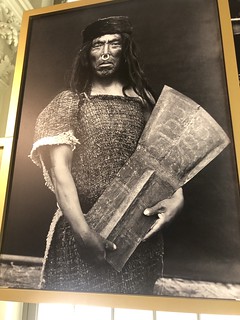
LEFT: South Pacific currency made from bird feathers
RIGHT: Native American in Canada with copper sheet money


Coins of Syracuse and Cleopatra
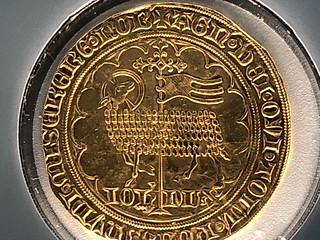
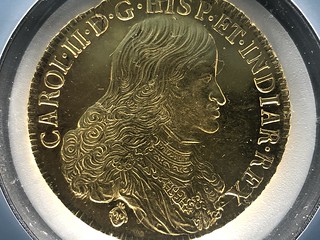
Gold coins


LEFT: Money changers desk
RIGHT: "Money changer and spouse, with example of cartoon legend

Printing Belgian bank notes

Original artwork for Belgian 100 franc note
To view the complete photo gallery on Flickr, see:
https://www.flickr.com/photos/coinbooks/albums/72157711012593227
(https://www.flickr.com/photos/coinbooks/albums/72157711012593227)

VOCABULARY: ESSAY, TRIAL AND EXPERIMENTAL PIECES
Dick Johnson submitted these entries from his Encyclopedia of Coin and Medal Terminology. Thanks! -Editor
Essay. A trial piece or proof of a design that may, or may not, be accepted. See PROVING, TRIAL PIECE. Essay is not to be confused with assay, a testing of metal fineness. The term is spelled essai in French and this has appeared on numismatic items.
Trial Piece. A die trial, often made in a softer metal than that of the intended composition. It is also called a trial strike because it is stuck when the dies are first placed in a press and such an early impression is made. These first impression strikes are more likely to have imperfect die alignment, pressure and rotation. It lacks depth of relief as the pressman purposely starts with a light impression (not to break the dies). He increases the pressure with subsequent strikes until he is satisfied the correct pressure will form a completely struck up piece filling every die cavity. He will also rotate the obverse and reverse dies until the alignment is correct. See die alignment.
If the trial piece is not the same composition of the intended piece, it is termed an off metal strike. Pieces intended to be struck in bronze would have tin, lead, white metal or aluminum trial strikes; silver or other precious metal pieces would have bronze, brass or other trial strikes. Should the piece be struck in the intended composition, obviously, it is not a trial strike but an early production piece.
The testing of dies before they go on a press is more correctly termed proving. The die can be examined at any stage of creation, as incomplete designs at an early stage of engraving the die, or of some element that will be sunk into the completed die. If the engraver makes this test piece at his workbench, he would press the die into clay or wax for a fast inspection, or make a hot tin impression or splasher, by pressing the die into a small mound of tin or lead poured on paper for this purpose.
In Europe the term is more apt to be called ESSAY. Trial pieces of one or both completed dies are often made in lead, called lead proofs. See proving.
History of trial pieces. The first use of the term occurred when Thomas Simon prepared his Petition Crown in 1663 with a revolutionary edge device (an edge die on spring steel that sprung out after the piece was struck). The edge lettering read: Thomas Simon most humbly prays your Majesty to compare this his tryall piece with the Dutch and if more truly drawn & emboss'd more gracefully order'd and more accurately engraven to relieve him."
See die trial, proving, ESSAY.
Reference:
NE42 {1982} Doty, p 333-334.
Experimental Piece. A trial piece in which some technological or innovative process is tested, such as: a new composition, a new piece of equipment, a new process of striking, or even a new process of finishing. It is not a die trial An experimental piece must be a test of some new innovation. If a small trial run is made the struck piece may be termed test coin; the Canadian Royal Mint has made these testing an innovative bimetal composition. See die trial, trial piece.
Looking for the meaning of a numismatic word, or the description of a term? Try the Newman Numismatic Portal's Numismatic Dictionary at: https://nnp.wustl.edu/library/dictionary
Or if you would like a printed copy of the complete Encyclopedia, it is available. There are 1,854 terms, on 678 pages, in The Encyclopedia of Coin and Medal Technology. Even running two a week would require more than 19 years to publish them all. If you would like an advance draft of this vital reference work it may be obtained from the author for your check of $50 sent postpaid. Dick Johnson, 139 Thompson Drive, Torrington, CT 06790.
CHARLES LEOPOLD PODHAISKI (1854-1913)
Charles Leopold Podhaiski (1854-1913), was born in Austria and was naturalized in 1878.
From June 17-18, 1892, the Podhaiski Collection of 700 lots of antiquities, ethnology, curios and coins were sold by James P. Silo, New York. Some highlights of that auction reveal him to be a collector of numismatic materials of odd and curios money apparently from an anthropological perspective, and other foreign and American coins. Several numismatic items are of carved gems, and the like.
Lot 5. Greeley Brown Medal, busts jugate.
Lot 47. Gold coin scale and weights
Lots 68-72. Limoges medals.
Lot 114. Bust of Carolus Carraffa, Cardinal, plated in frame, Rome.
Lot 118. Bust of Ferdinand II, plated in frame, Spain.
Lot 137. Carnelian ring stones.
Lot 138. Cut Topaz Pendants.
Lot 146. Copper Money Bracelet, Mandingo, Africa.
Lot 152 & 153. Iron Fan Money.
Lot 163. Shell Money Bracelet, Nassau.
Lot 164. Wampum, Solomon Islands.
Lot 169. Shell Money, Samoan Islands.
Lot 207. 18th century Palestinian Carved onyx Head of Christ
Lot 216. Cut Amethyst ring stones, 50 pcs.
Lot 218. Engraved Copper Plate.
Lot 225. Engravings of Indian coins, &c.
Lot 233. Shell cameos.
Lot 241. Mother-of=pearl carving "Dying Lion of Lucerne".
Lot 242. Same but in ivory.
Lot 255. Collection of cameos, 125 pcs.
Lot 270. 16th century Round Delft Plaque of Woman Holding an Instrument.
Lot 288. Wax carving of the Holy Family on Flight into Egypt.
Lot 293. Glass intaglio bust of Frederick Francis I, Grand Duke of Mecklenburg-Schwerin.
Lot 321. Engraved Portraits, 3 pcs.
Lot 323. Engravings of Fruit Pickers in gilt frame.
Lot 328. Steel Engravings "Image Breaker of Leutze," et alia, 3 pcs.
Lot 436. Silver Medal, with cross, gilt mostly worn.
Lot 437. Another.
Lot 439. Another, but with Christ holding Gospel Book.
Lot 443. Double medal of Virgin and Child, and scenes from the life of Christ.
Lot 481. Pair of Silver Maximilian Half Dollar Sleeve Buttons
Lot 482. Pair of Wood's Ministrel Token Sleeve Buttons,
Lot 502. Carved Seal of Cupid.
Lot 512. Bust of Flora in red, pin.
Lot 513. Limoges Lady Portrait.
Lot 514. Repousse Madonna Medal, gilt.
Lot 515. Gilt Venetian Silver Temple.
Lot 520. Coin jewelry.
Lot 521. Gypsy coin chain 75 coins.
Lot 522. Same 107 coins.
Lot 531. Carved gems.
Lot 535. Coin jewelry.
Lot 571 Carved Gem ring.


C. L. Podhiski letter to Chapmans
 Thomas Elder tells us in
one of his series of reminiscences published in Hobbies of the May 22, 1902, Lyman Low coin auction: "the old bewhiskered Charles Podhiski, of gruff-voice, who bought
coins for Charles Gregory, then a member of the Stock Exchange."
Thomas Elder tells us in
one of his series of reminiscences published in Hobbies of the May 22, 1902, Lyman Low coin auction: "the old bewhiskered Charles Podhiski, of gruff-voice, who bought
coins for Charles Gregory, then a member of the Stock Exchange."
In 1909, he was a member of the New York Numismatic Club.
To read the complete article, see:
PODHAISKI, CHARLES LEOPOLD
(https://sites.google.com/a/numismaticmall.com/www/numismaticmall-com/podhaiski-charles-leopold)
The entire inventory of the Lupia Numismatic Library is for sale. Individual items will be available before the remaining archives are broken up into parcels sold at philatelic auctions in the U. S. and Hong Kong. Check NumismaticMall.com frequently as dozens of new items with estimates will be posted daily until everything is sold.
All inquiries will be given prompt and courteous attention. Write to: john@numismaticmall.com .
CHICAGO HALL OF FAME INDUCTS ARLIE SLABAUGH
The Chicago Coin Club has announced the tenth inductee into its Hall of Fame. -Editor
Inducts Arlie R. Slabaugh Into its Hall of Fame
The Chicago Coin Club announces that the tenth person to be inducted into its Hall of Fame is author and editor Arlie R. Slabaugh. His Hall of Fame citation has been published on the club’s Hall of Fame web page, www.chicagocoinclub.org/projects/hof.
Twelve Hall of Fame inductees have been selected. The remaining two will be announced one a month, November and December, during the Chicago Coin Club’s centennial year, 2019.
The Chicago Coin Club was organized in 1912 as American Numismatic Association Branch No. 1, and reorganized under its present name in 1919. All are invited to join. To become a member you must attend a meeting and submit an application along with a membership fee of $20 ($10 for Junior membership). A first reading of your application will be held at this meeting, and a second reading at the next monthly meeting, following publication of your name in the club newsletter. (You are not required to be present for the second reading.) Upon membership approval, you will become a member.
The Chicago Coin Club holds monthly meetings in downtown Chicago, plus at major numismatic conventions such as Central States, with a speaker featured at every meeting except the annual auction, held at the November meeting.
Here is the text of the Arlie Slabaugh entry. -Editor
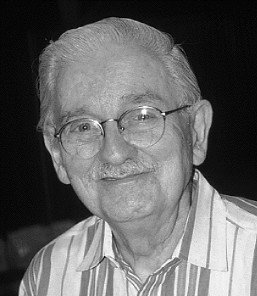 Arlie R. Slabaugh was appointed Assistant
Editor of the Numismatic Scrapbook in April 1954 and moved to the Chicago area from Artie, “among the West Virginia hills.” The next month, on May 14, he joined the Chicago
Coin Club as member No. 619. A frequent exhibitor of wartime currency and unusual numismatic items, he was recognized for one of the best exhibits at the Club’s 1954 annual
banquet. At the December 1956 meeting, he read an original poem, “A Christmas Phone Message,” asking Santa to bring all the members of the club the items they wanted. He received
the Club’s Literary Award in 1961 and 1965; its highest honor, the Medal of Merit, was presented to him in 1966.
Arlie R. Slabaugh was appointed Assistant
Editor of the Numismatic Scrapbook in April 1954 and moved to the Chicago area from Artie, “among the West Virginia hills.” The next month, on May 14, he joined the Chicago
Coin Club as member No. 619. A frequent exhibitor of wartime currency and unusual numismatic items, he was recognized for one of the best exhibits at the Club’s 1954 annual
banquet. At the December 1956 meeting, he read an original poem, “A Christmas Phone Message,” asking Santa to bring all the members of the club the items they wanted. He received
the Club’s Literary Award in 1961 and 1965; its highest honor, the Medal of Merit, was presented to him in 1966.
Mr. Slabaugh (April 26, 1925 - September 26, 2007) began collecting as a schoolboy; at 13 he sent 10 cents to a dealer for a banknote and foreign coin, and soon had an interest in numismatics so “serious” that he founded his own magazine, The Hobby Spotlite, then just a single page with limited circulation but later a printed, national publication. He joined the ANA at 16, but on January 22, 1942 was stricken with “mastoiditis” and hospitalized for three weeks, leaving him completely deaf, but he learned to read lips and continued to speak. At the West Virginia School for the Deaf he studied journalism and printing, though this scarcely interrupted his writing and publishing. By 1948 he was the first full-time dealer in world paper money in the United States, but was “glad to receive a regular pay check” from the Numismatic Scrapbook. Here he excelled until lured away by the Franklin Mint in Pennsylvania in 1967 as Director of Numismatic Information, remaining with them until 1985.
His first book (40 p.), The German Inflation, self-published in 1947, was reprinted from the Numismatic Scrapbook, 1945-46. But his most lasting contribution was Confederate States Paper Money, published by Whitman in 1958; an eleventh edition was released in 2008 under a modified title. On other wartime emergency monies, he wrote Encased Postage Stamps, U.S. and Foreign (1967), Japanese Invasion Money (1963, fifth ed. 1977), and Prisoner of War Monies and Medals (1965, second ed. 1969). Other longer works covered U.S. commemorative coins, small size National Bank Notes, and several exonumia categories. Besides these booklets, he contributed scores of articles to the Numismatic Scrapbook, The Numismatist, the TAMS Journal, and Paper Money.
A charter member of the Token and Medal Society, he was an assistant editor of the TAMS Journal and received their Medal of Merit in 1967; he served as President 1978-1980. The Society of Paper Money Collectors presented him with its Nathan Gold Memorial Award for lifetime achievement in 1963. The Numismatic Literary Guild honored him with their highest award, the Clemy, in 1981. He was voted a Numismatic Ambassador in 1989. And from the ANA, Mr. Slabaugh received a Heath Literary Award in 1948; two B.P. Wright Exhibit Awards, 1965 and 1966; the Medal of Merit, 1991; the Glenn Smedley Memorial Award and a President’s Award, both in 1997; and the Lifetime Achievement Award, 2004.
Although deaf and with limited education, he cheerfully overcame these difficulties and pioneered the study of many exonumia and synographic areas, combining historical and technical accuracy with a matter-of-fact, folksy writing style. His genius was such that, while typesetting on a linotype machine at the Numismatic Scrapbook, he could anticipate what space would remain after the article and compose a short item to fill it before he reached the bottom of the page.
To read the complete article, see:
Hall of Fame – Chicago Coin Club – Member 10 Arlie R. Slabaugh
(http://www.chicagocoinclub.org/projects/hof/m10.html)
To read the earlier E-Sylum article, see:
CHICAGO HALL OF FAME INDUCTS ELSTON BRADFIELD (https://www.coinbooks.org/v22/esylum_v22n35a19.html)

HARVEY STACK'S NUMISMATIC FAMILY, PART 53
The latest article in Harvey Stack's blog series focuses on coin auctions of 1969, including the Gaston Dibello sale. -Editor
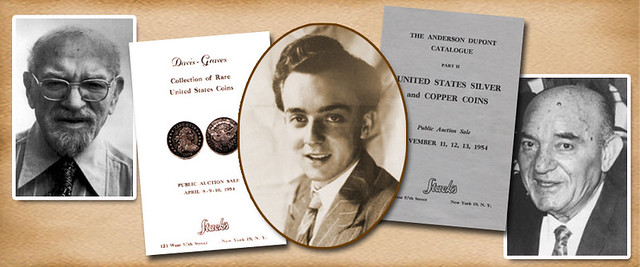
While the R.L. Miles Collection was a highlight, Stack's was able to present many other fine public auctions in 1969. In May Stack's offered the Illinois Collection, a comprehensive assemblage of ancient, foreign and United States gold coins, consisting of some 1,011 attractive numismatic lots.
The month of June brought a fabulous collection of Greek and Roman gold, silver, and bronze coins, assembled by Fred V. Fowler over four decades and containing pieces from some major collections that had been offered earlier in the 20th century. The Fowler Collection contained over 1,200 lots of ancient coins, tracing early Greek and Roman monetary history. Among the highlights of the Greek offering was the decadrachm of Syracuse, decadrachm of Carthage 1st Revolt of Judea, and a 1 1/2 Gold stater of Carthage. In the Roman section, 420 lots, all the Emperors were represented, many in gold and others in silver. Together with the Greek portion, it provided an important opportunity for bidders to add to their Ancient world collections.
In September we offered the extensive collection of Calvert Emmons, which had been started by his father in the late 19th century. It featured United States gold, silver and copper coins in wonderful condition and was quite complete in some areas. Calvert Emmons was an officer at the Bank of America, where he had served for some 30 years. He loved adding coins to his collection, and even went to several auctions. Among the other rarities in his collection were two examples of the very rare 1884 trade dollar.
In October, Stack's was awarded the fabulous Gaston Dibello Collection of foreign coins for auction. This was another example of the firm being offered the opportunity to sell a collection we had been involved in building, as we had been serving Mr. Dibello since the end of World War II. Gaston was a prominent industrialist before and after the war, and was a longtime client of the Stack's. His first love was the coins of Italy where he was born. Early in life he moved to Buffalo, New York where he made his fortune. He expanded his collection after the war and ended up with an outstanding collection of gold coins.
Gaston was a dedicated numismatist. He not only collected coins, but also helped form the Buffalo Numismatic Society and was president and treasurer of the club. In his local area he was guided by John J. Pittman in making some of his purchases. He exhibited portions of his collection all over the country, and won many first prize awards for his displays. He was among the few that traveled to Egypt when the famous King Farouk Collection was sold by the Egyptian government in 1954. He always said that he didn't feel totally safe making that trip, but he did it anyway, as it was an important opportunity to add rarities to his collection. His friend John J. Pittman was part of the small group of Americans who went. All were successful in getting some wonderful coins from the Farouk Collection.
Since Gaston's collection was so large and had many rarities, Stack's suggested that it be sold in two parts, one in fall 1969 and the other in spring 1970.
As Gaston Dibello had an affection for the coins of Italy, he assembled over 350 pieces from that country, from coins of the Renaissance up to the 1930s, as well as early Italian city and state issues. He had different denominations and types, mostly in very nice condition. It was one of the largest collections of the coins of Italy ever sold in the United States. The collection also contained a wonderful selection of coins from Great Britain, the rest of Europe, Africa and South America. Sold in two session, it was the most important comprehensive collection of gold coins of the world offered in the United States since World War II. The coins in the sale set one record after another due to their quality and rarity.
Stack's concluded the year of 1969 with a comprehensive offering of several collections that included U.S., foreign and ancient gold, silver and copper coins.
As a new decade approached, interest in rare coins continued to increase and Stack's was able to take advantage of the growing market through auctions and buying and selling, both over the counter and through the mail.
To read the complete article, see:
Harvey Stack Remembers: Growing up in a Numismatic Family, Part 53
(https://www.stacksbowers.com/News/Pages/Blogs.aspx?ArticleID=harvey-stack-remembers-53)
To read the earlier E-Sylum article, see:
HARVEY STACK'S NUMISMATIC FAMILY, PART 52 (https://www.coinbooks.org/v22/esylum_v22n36a15.html)
ANS 2020 GALA HONOREE RICHARD M. BELESON
The ANS has announced its honoree for their 2020 Gala. -Editor

Richard M. Beleson
The American Numismatic Society (ANS) is pleased to announce that on Thursday, January 16, 2020, it will honor its esteemed former Trustee Richard M. Beleson with the Trustees’ Award at the Annual Gala Dinner at the Harvard Club in New York City.
Richard Beleson, of San Francisco, California, holds an M.B.A. in Finance and Accounting from the Graduate School of Management, University of California, Los Angeles, and a B.S. in Biological Sciences from Stanford University. Beleson, one of the first analysts to cover biotechnology stocks, worked for twenty-five years at the Capital Group Companies.
He has been a steadfast supporter of the ANS for many years, ever since joining the Society in 1995, and served on the Board of Trustees from 2010 to 2016. He is also a generous donor to the Society’s Campaign to Endow the Chair of the Executive Director.
Although born in New York City, Mr. Beleson spent much of his youth abroad, as his family traveled to sites in England, Italy, Greece, Turkey, Israel, and Egypt. He attended a British primary school, and it was there that his interest in ancient history and archaeology was first stimulated. That, in turn, quickly led to a lifelong fascination with ancient coins. He can easily date the beginning of his collection: he bought his first ancient coin in the Grand Bazaar in Istanbul in 1964, when he was ten years old. Just a year later, he also developed an interest in shipwreck coins, after reading about Kip Wagner and the Real Eight Company in the January 1965 issue of National Geographic.
Eventually, as an adult, Mr. Beleson would become part of a treasure salvage group in Florida, and on July 31, 2015—exactly 300 years to the day after the hurricane that sunk the 1715 Plate Fleet—he was on board Brent Brisben’s salvage vessel the Capitana when it found 350 gold coins, including 9 gold royals, off Vero Beach. It was one of the greatest sunken treasure finds ever recorded.
“I can think of few people who are as committed to our field as Rick,” says ANS Executive Director, Dr. Ute Wartenberg. “I greatly admire his dedication to supporting scholars and projects, but also his local coin club. He is a collector who gives back to the community all the time. I am so very happy that the ANS will honor him at our Gala.”
In acknowledgment of his exemplary commitment to numismatics and his great generosity to the ANS, the Board of Trustees of the American Numismatic Society is delighted to bestow upon Mr. Beleson the Society’s singular honor for 2020.
Past recipients of the Trustees’ Award include such notable numismatists and donors as Ms. Shelby White and Mr. Leon Levy, Mr. Jamie Stewart, Mr. Kenneth L. Edlow, Mr. George Kolbe, Mr. Q. David Bowers, Mr. Chester L. Krause, Mr. Donald G. Partrick, Mr. Harvey Stack, Mr. Victor England, Jr., Mr. Ira Goldberg, Mr. Larry Goldberg, Mr. Harlan J. Berk, Mr. Roger S. Siboni, Mrs. Marian Scheuer Sofaer and the Honorable Abraham D. Sofaer, Mrs. Elizabeth Forbes Hazard Scott and Mr. Stanley DeForest Scott, and Mr. and Mrs. John W. Adams, Anthony J. Terranova, the Eric P. Newman Numismatic Education Society and the Newman Numismatic Portal, the Rosen Family, and Mike Gasvoda.
Every year the American Numismatic Society raises critical revenue through Gala ticket sales, program advertisements, sponsorships, contributions, and the proceeds from a live auction. These funds are used to further the Society’s mission of supporting research and education in numismatics.
For information on purchasing tickets or program advertisements, please contact Emma Pratte at 212-571-4470, ext. 117; membership@numismatics.org; or visit the ANS website: numismatics.org/gala2020.
ROBINSON 110TH AUCTION SELECTIONS
Here's the press release for dealer Frank Robinson's latest sale. Bibliophiles note: there are several lots of literature in Part 5 (lots 460-494) -Editor
Dealer Frank S. Robinson will conduct his 110th mail and internet auction of Ancient and Early Coins with a closing date of October 29. The sale will include 494 lots, with low minimum bids, and bids to be reduced as competition permits. Robinson notes that reductions have averaged 15-20% in his recent sales. There is no buyer fee.
Noteworthy among Greek coins in the sale are two classic Athenian “Owl” Tetradrachm in Choice EF, two rare early Elymais silver tetradrachms; an archaic Kaulonia stater; a rare Persis Tetradrachm of Autophradates II in EF; and good run of Parthian coins.
Roman highlights include a VF Pompey denarius; an AEF denarius of Mark Antony and Octavian; a high grade Sestertius of Nero Claudius Drusus; a Denarius of Galba in VF; an EF Orbiana denarius; and a Choice EF Quietus
The auction also includes Byzantine and other early coinages, group lots, literature, and a section of items offered at fixed prices
Robinson holds about three such sales annually, and tries to offer a broad range of material for advanced collectors as well as bargain hunters. Catalogs are free; contact Robinson at Box 8600A, Albany, NY 12208; phone/fax 518-482-2639; e-mail frank@fsrcoin.com. The full catalog will be at his website, http://www.fsrcoin.com/t.html
There's a nice selection of moderately-priced coins here. Here are some lots that caught my eye. -Editor
Lot 11: Greek, Athens Athena Head
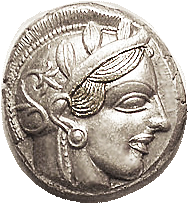
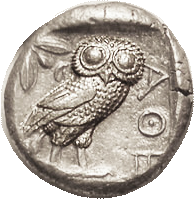
ATHENS, Tet, 449-413 BC, Athena head r/owl stg r, S2526; Choice Virtually Mint/EF, obv quite nicely centered with much of helmet crest present; rev nrly centered. Perfect fresh metal and well struck with the obv hair waves sharp. That's what I look for on these. Most of the numerous examples from recent hoard lack this.
Very nice! It's hard to find a piece so well centered and struck. -Editor
Lot 32: Ptolemy III
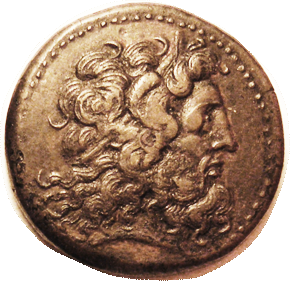
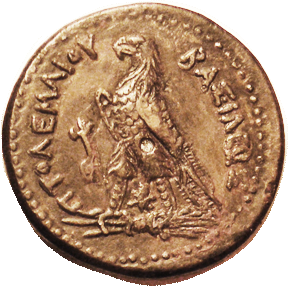
Ptolemy III, Æ35, Zeus Ammon head r/Eagle l, Chi-Rho monogram betw legs, Choice VF+, centered & boldly struck, good smooth dark brown surfaces, excellent detail. (A VF realized $518, CNG 9/06.) Starting Bid $175
A classic style. I like the big, bold eagle. -Editor
Lot 38: Kamnaskires III & Queen Anzaze
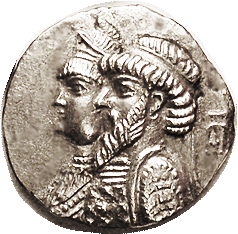

ELYMAIS, Kamnaskires III & Queen Anzaze, c. 82-80 BC, Ar Tet, Conjoined busts left, anchor behind/Zeus std l., lgnd around, S6171 (£1250); EF, well centered, rev typically crude with some planchet imperfections; obv beautiful with superb portrait quality. Rare. (A GVF with lt porosity & weak rev strike brought $4700, Triton 1/14.) Starting Bid $900
I like the conjoined busts. This pose is difficult to execute, but this one is done well. Nice coin. -Editor
Lot 125: Helios Head Didrachm


Didrachm, c.340 BC, Helios head facg sl rt/Rose, grape bunch & E; VF, obv well centered, a little crudeness but good strong face; rev sl off-ctr but complete & bold; decent metal with accentuating tone. (This exact variety, GVF, brought $1430, CNG 9/01.) Starting Bid $170
Well described. A face made for radio. -Editor
Lot 219: Antoninus Pius Denarius
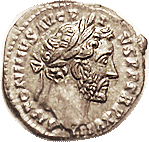

ANTONINUS PIUS, Den, COS IIII, Annona stg l, to right modius on prow; Choice EF, practically as struck, nrly centered with full lgnds, sharply struck with rev much stronger than usual, superbly detailed portrait; excellent metal with rich toning. Did I puff this up enough? (A Superb EF brought $748, CNG 5/12.) Starting Bid $120
Puff away, Frank! -Editor
Lot 405: 1722 George I Farthing
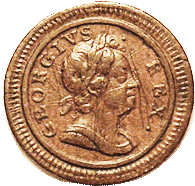

George I, Farthing 1722, Large Letters, Peck 824 (Rare); AEF, well struck, good chocolate brown surfaces, lustery on rev. Quite a few moderate obv scrs; however, this is still far above average condition. Spink EF £725. Ex my collection. (Compare a GF bringing $147, Baldwin's 5/06.) Starting Bid $50

SELECTIONS FROM HOLABIRD OCTOBER 5, 2019 SALE
Here are some items that caught my eye in the upcoming October 5, 2019 session of Fred Holabird's October sales. -Editor
Lot 2313 : Current Gold and Silver Coins of All Nations

Extremely rare hardcover volume, inscribed by the publisher to Robt. S. Davis in 1884. 147 pages, 9 x 12 inches. Fifth edition by Ivan C. Michels, Ph.D., M.A. published by R.S. Menamin, Philadelphia. City: State: Date: 1884
For the bibliophiles. Great condition. -Editor
To read the complete lot description, see:
2313 Current Gold and Silver Coins of All Nations
81321 (https://holabirdamericana.liveauctiongroup.com/Current-Gold-and-Silver-Coins-of-All-Nations-81321_i34457187)
Lot 2339: Palace Mills 25 Cent Note
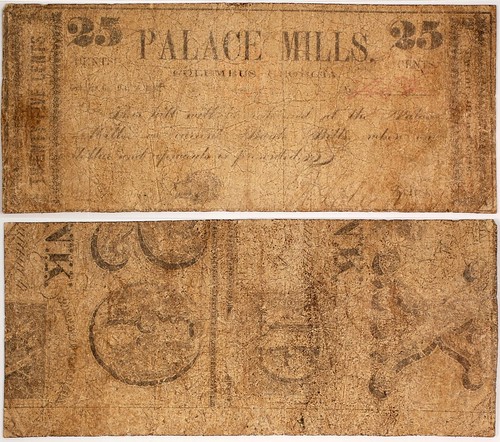
PMG Very Good 8. Serial number 452, printed on Pigeon Roost Mining Company paper. (1724443-007) City: Columbus State: Georgia Date: 1861
Civil War era merchant scrip is incredibly varied and great fun to collect. -Editor
To read the complete lot description, see:
2339 Palace Mills 25 Cent Note 58158
(https://holabirdamericana.liveauctiongroup.com/Palace-Mills-25-Cent-Note-58158_i34457213)
Lot 2375: Art Nouveau Nude Medal

Bronze, 90 mm, art nouveau style "Feriam Sidera", nude and storks, M. Dammann, French mint. City: State: Date: 1920
Nice composition. Hadn't seen this one before. -Editor
To read the complete lot description, see:
2375 Art Nouveau Nude Medal 108622
(https://holabirdamericana.liveauctiongroup.com/Art-Nouveau-Nude-Medal-108622_i34457249)
Lot 2386: Lindbergh Long Eagle Medal
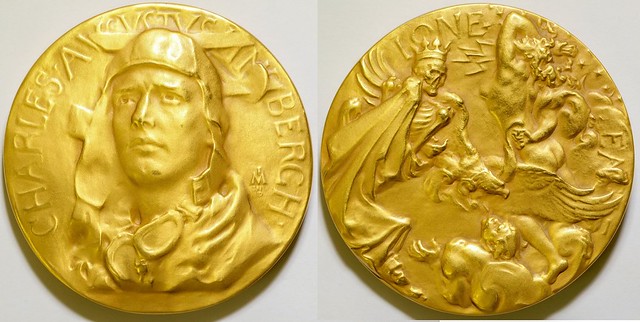
Society of Medalists fourth issue, in original box, designed by Frederick MacMonnies. 72 mm. City: State: Date: 1931-1963
Beautiful medal. -Editor
To read the complete lot description, see:
2386 Lindbergh Long Eagle Medal 108626
(https://holabirdamericana.liveauctiongroup.com/Lindbergh-Long-Eagle-Medal-108626_i34457260)
Lot 2425: Coin Scale

A very rare coin scale with weights die cast as coins for specific coin counterfeit detection. Case 3 x 7", 14 replica coins with detail on only one side. One piece has small counter stamps/hallmarks on the back, and must have been checked by an outside party for correctness. Coin replica/likenesses from Spain, Italy. Appears to be late 18th century, probably Italian. Purchased by collector in Milan, decades ago. In the scale collections we've seen over 40 years (easily over 1000 scales), we haven't seen this one.
Coin scales are a great numismatic collecting sideline. Lots of history. -Editor
To read the complete lot description, see:
2425 Coin Scale Counterfeit Detector Book 61334
(https://holabirdamericana.liveauctiongroup.com/Coin-Scale-Counterfeit-Detector-Book-61334_i34457299)
ARCHIVES INTERNATIONAL SALE 55 ANNOUNCED
Here is the announcement for the October 10, 2019 sale by Archives International Auctions. -Editor
U.S., CHINESE & WORLDWIDE BANKNOTES, SCRIPOPHILY AND SECURITY PRINTING EPHEMERA TO BE OFFERED AT PUBLIC AUCTION ON THURSDAY, OCTOBER 10TH, 2019
The auction will be held by Archives International Auctions at their new offices in River Edge, N.J.
 The October 10th
auction by Archives International Auctions will consist of 1178 different lots offered in three sessions beginning with 375 lots of Chinese and Worldwide Banknotes, Coins and
Russian Scripophily. The second session features over 249 lots of U.S. Obsolete Banknotes and Security Printing Ephemera highlighted by Part 1 of the Highlands Collection of New
Jersey Obsolete Bank and Scrip notes. The third session features U.S. & World Scripophily with 561 lots including an outstanding railroad stock and bond collection of CSX and
related railroads with many rarities never seen previously by the collecting community.
The October 10th
auction by Archives International Auctions will consist of 1178 different lots offered in three sessions beginning with 375 lots of Chinese and Worldwide Banknotes, Coins and
Russian Scripophily. The second session features over 249 lots of U.S. Obsolete Banknotes and Security Printing Ephemera highlighted by Part 1 of the Highlands Collection of New
Jersey Obsolete Bank and Scrip notes. The third session features U.S. & World Scripophily with 561 lots including an outstanding railroad stock and bond collection of CSX and
related railroads with many rarities never seen previously by the collecting community.
“We are excited to offer part 1 of the Highlands Collection, an extensive New Jersey Obsolete Banknote collection that has been off the market for over 30 years”, stated Dr. Robert Schwartz, President of Archives International Auctions. “Our current 55th auction will offer 1187 lots of rare and desirable U.S. & Worldwide Banknotes, Scripophily and Security Printing Ephemera with many rare and desirable items seldom offered at auction including items for the beginner to the advanced collector”.

Included in the sale are consignments from numerous estates and longtime collections with many items having never been offered previously at auction. A few of the many World highlights begin with a Commonwealth of Australia, 1918, 10/- Shillings, P-3b rarity; China features over 80 notes with a number of highlights including a Bank of Communications, 1913 $10, P-111As Specimen with only 2 previous auction appearances over the last 10 years; a spectacular and high grade 1905 International Banking Corp., Shanghai Branch $100 Specimen in PMG 65 EPQ is offered and is sure to attract attention as well as numerous issued and specimen Chinese banknotes being offered; An extremely rare Denmark, 1784 Copenhagen, 1 Rigsdaler Courant issued note in Fine to VF condition from the John E. Herzog Collection is offered; France is highlighted by a 1790, Caisse d’Escompte, 200 Livres, P-A24 rarity, also from the Herzog collection and having last been seen at auction in 2001 with no others appearing since; Hong Kong has a number of noteworthy offerings including a spectacular pair of Mercantile Bank of India notes, a 1930, $5 and 1937, $10, both in VF condition; Mexico includes numerous desirable notes including a Banco del Estado de Durango, 1882, 1 Peso, Remainder Banknote Rarity; Russia includes a new find of Imperial Russian Government, 1915 and 1916 Specimen Bonds never offered previously in the U.S.. Hundreds of additional desirable notes are included that should appeal to every level of collector and dealer.

Session 2 features over 249 lots of U.S. Obsolete Banknotes, National Banknotes, Small and Large Type as well as Security Printing Ephemera and Historic Ephemera. One of the main highlights is a Central Bank of Brooklyn, 1850's Uncut "Santa Claus" Proof Sheet of 4 Notes with no recent record of a sheet being offered with the desirable Santa Vignette in over 10 years; Part 1 of 2 parts of the Highland Collection of New Jersey Obsolete Scrip and Banknotes will debut in the auction. There are over 150 lots in Part 1of the auction, with many lots including multiple items that deserve further research and will offer many surprises for the serious collector and student of New Jersey numismatic history. One of the many highlights of the Highland Collection is an 1837 Issued Newark Whaling, Sealing & Manufacturing Co. 37 1/2 Cent note with a popular whaling vignette; hundred of additional notes from the collection are sure to attract attention. Two different Nevada National Banknotes are offered including a $50, 1929, T-1, Reno National Bank Charter #7038 note; Security Printing Ephemera includes numerous rare items that have been off the market for decades including several very rare and desirable items from the John E. Herzog collection. A rare group of 5 CDV’s photographed by Meserve, all of Civil War Military men including Grant and Sheridan in uniform are included. Session 2 also includes hundreds of additional desirable and rare items that will be of interest to the discriminating collector.
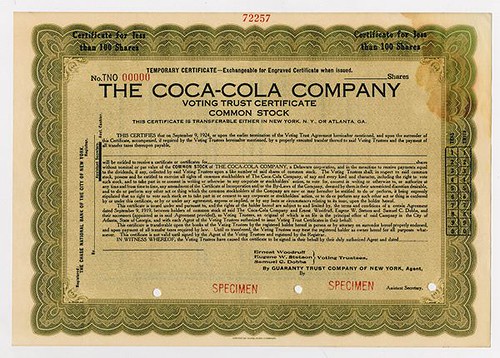
The 3rd Session of 561 lots consists of U.S. & World Scripophily, featuring the Stephen Beck Collection of CSX and Predecessor Railroad Bonds and Shares and ends with additional selections from the American Bank Note Commemoratives Inventory of Show & Souvenir Obsolete Banknote and Vignette cards. Some of the many highlights include very possibly one of the first Coca-Cola Share Certificates, a 1919 Specimen Voting Trust Certificate Temporary Stock Certificate. No other earlier Coca-Cola certificates have been found in issued or Specimen condition; 2 different Puerto Rico, 1893 and 1895, Credito y Ahorro Ponceno Sociedad Anonima Specimen Bond rarities; a Historic U.S. Department of the Interior, 1894 Specimen U.S. Federal Cherokee Nation Bond codifying the U.S. Government purchase from the Cherokee tribe the lands in Oklahoma known as the “Cherokee Outlet”; an extremely rare North American Italian Steam Ship Co., 1866 with Red 25cts Imprinted revenue RN-T3; a unique, New York, Twenty Third Street Railway Co., 1889 Specimen Equipment Bond from the ABN Archives; a NY, Staten Island Rail-Road Co., March, 1864 Stock Certificate With William H. Vanderbilt Signature and hundreds of additional stocks and bonds from a large variety of topics from railroads, automobiles, technology, Government, Foreign, mining and dozens of additional topics.
Previews will be held at Archives International Auctions offices beginning Monday, October 7 th to Wednesday, October 9 th between 10 AM and 5 PM and by appointment. For an appointment call 201-944-4806 or email info@archivesinternational.com.
The online catalog for the October 10 th sale is on Archives International Auctions’ website and can be viewed via the Archives International live bidding platform. It can also be viewed as a Virtual Catalog or downloadable Sale 55 .pdf on their website. To pre-register for live internet bidding, log on to the Archives International Auctions website, at www.ArchivesInternational.com.
Archives International is now working on their Late Fall 2019 auctions and are seeking quality consignments for future auctions or outright purchase including U.S. and worldwide banknotes, coins, stocks, bonds, stamps, postal history, historic ephemera, and autographs. To sell or consign one piece or an entire collection, please call AIA at (201) 944-4800; or e-mail them at info@archivesinternational.com.
You may also write to Archives International Auctions, at 1060 Main Street, River Edge, NJ 07661, U.S.A. To learn more about Archives International Auctions and the auctions planned for October 10th , log on to www.ArchivesInternational.com.

WAYNE'S NUMISMATIC DIARY: SEPTEMBER 22, 2019
Tuesday September 17th was Constitution Day in the U.S. It was also the meeting night of my northern Virginia numismatic social group, Nummis Nova. Wayne Herndon was our host for the evening at Mon Ami Gabi, a restaurant in Reston Town Center.
I was among the last to arrive at 6:30 and took a seat between Wayne and Eric Schena. Other members attending were Dave Schenkman, Robert Hoppensteadt, Chris Neuzil, Mike Packard, Tom Kays, Julian Leidman, Roger Burdette, and Jon Radel. Tom's guest was Jonas Denenberg, a young numismatist who belongs to the Fairfax Coin Club.
We were crowded around a fairly small rectangular table setup, but we managed to find enough room to pass around an interesting array of numismatic items. I brought along a couple of books purchased at last month's ANA World's Fair of Money.


I also brought along some star notes I'd discussed in my previous diaries and a group of dollar bills with several different political slogans. I had bought a stack of 50 of them from Tom Sheehan and selected one example of each type for my collection. I offered the others to the dinner attendees at face value.
Girl on the Silver Dollar
 Roger surprised us with
a gift for all attendees of a signed copy of his new book, Girl on the Silver Dollar. See the article elsewhere in this issue for more information. Roger is a careful and
meticulous researcher. The book will likely be the definitive word for decades to come on the identity of the model for the Morgan silver dollar.
Roger surprised us with
a gift for all attendees of a signed copy of his new book, Girl on the Silver Dollar. See the article elsewhere in this issue for more information. Roger is a careful and
meticulous researcher. The book will likely be the definitive word for decades to come on the identity of the model for the Morgan silver dollar.
Dave's Delicacies
Dave Schenkman always has some great numismatic items to share. He kindly provided these images of his display items. Thanks! The first item is a crudely counterstamped 1797
British penny.

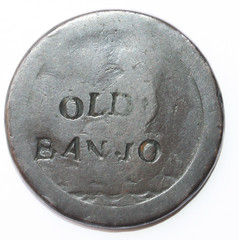
Dave writes:
The song “Old Dan Tucker” was written in the early 1840s, and during that time was performed by the Virginia Minstrels. It has been recorded countless times over the years, by everyone from Pete Seeger to Bruce Springsteen. I got it last month from My good friend, Dick Grinolds, at the ANA convention. As I recall our conversation, it went something like this:
Dick: Here’s something I brought for you.
Me: That’s very neat; how much is it?
Dick: I paid $20, what do you offer?
Me: How about $35?
Dick: How about $25?
Me: What about $30?
Dick: Sold.
What a way to run a business!
Well, it's a great way to run a hobby, with people looking out for each others' special interests. Very interesting piece.


Dave writes:
Here’s the silver British medal I passed around. It is dated 1702, and commemorates the capture of towns on the River Meuse.
A great piece. Even in the dim light at dinner I could tell this was nice.

The last piece is an interesting odd-denomination obsolete note, from Richmond, Ohio.
The Standard Catalog of Annandale, Vienna, and Dulles Coin Show Kids Auction Scrip
Tom Kays writes:
 I invited Jonas Denenberg of the Fairfax Coin Club to join Nummis Nova for dinner. Jonas is a young numismatist who
often gives coin talks, does original numismatic research, and also debuted his latest book, The Standard Catalog of Annandale, Vienna, and Dulles Coin Show Kids Auction
Scrip. Jonas’ book is dedicated to Jon Radel, the creator of the rare Series 2 and 3 Scrip, who in a pinch, found a way to let the show go on, when Series 1 Scrip ran out, or
was forgotten in moving boxes of supplies needed to run the Kid’s Auction.
I invited Jonas Denenberg of the Fairfax Coin Club to join Nummis Nova for dinner. Jonas is a young numismatist who
often gives coin talks, does original numismatic research, and also debuted his latest book, The Standard Catalog of Annandale, Vienna, and Dulles Coin Show Kids Auction
Scrip. Jonas’ book is dedicated to Jon Radel, the creator of the rare Series 2 and 3 Scrip, who in a pinch, found a way to let the show go on, when Series 1 Scrip ran out, or
was forgotten in moving boxes of supplies needed to run the Kid’s Auction.
Jonas covers the history of Kids Auction Scrip, the advent of the three series, postulates a new 4th series now that these events have transitioned from Nummis Nova to Fairfax Coin Club control, and captures rarity, provides a grading guide, talks to proper Scrip storage, and most wondrous of all, Jonas provides a price list showing the rare editions are worth much more than face value. This is how it is done folks.
Jonas further explains “Virtual Auction Bit-Bucks” once offered to E-Sylum readers, “backed by your good faith in our sketchy intentions to ever redeem them” still have no value. Jonas has our number for sure. Using modern marketing techniques Jonas has licensed his book and may need to go to a second printing soon. Jonas told Roger Burdette that he has not made any money on his book, and Roger assured him this is par for the course in the numismatic book writing business. Signed 1st editions are already sold out, and we look forward to the next numismatic title from the desk of Jonas Denenberg.
Networking with Wizard Coin Supply owner, Wayne Herndon, Jonas will have to wait a while before taking summer employment, since Wizard employees must be at least 16 years of age. Jonas is planning to enter a Young Numismatist exhibit on Saturday at the 61 st Annual, Virginia Numismatic Association Convention, Coin, Currency, and Stamp Show in Fredericksburg, Virginia at the Fredericksburg Convention Center, Carl D. Silver Parkway, Friday, September 27th through Sunday, September 29th, with a display of Odd Denomination U.S. Coinage, that I hope you see and enjoy.
To order or dowmload a copy of Jonas's book, see:
histocoins.com .
 FAO Coin Catalog
FAO Coin Catalog
Jon Radel brought along a copy of this 2017 book on FAO coins - these were organized by the United Nations Food and Agriculture Organization and issued by 119 countries. See the
article elsewhere in this issue for ordering information.
It was a great evening, as always. 'Til next month!
THE INFAMOUS "NE" PINE TREE SHILLING
James McCartney of Stack's Bowers published a blog article on a counterstamped Pine Tree Shilling that has intrigued numismatists for 150 years. The coin is offered in the firm's upcoming November 2019 Baltimore sale. The counterstamp is at the bottom of the obverse. -Editor
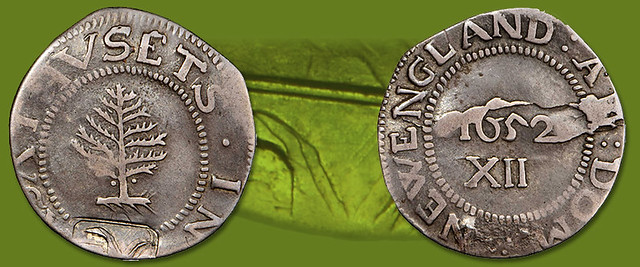
Featured in our November 2019 Baltimore Auction is a remarkable 1652 Pine Tree shilling with an infamous counterstamp that has captured the attention of specialists for nearly 150 years. Placed just below the roots of the tree on the obverse is an inverted counterstamp of the monogram NE, imitating the authentic NE punch used on the eponymous shillings of the Massachusetts Bay Colony. Close study reveals that the counterstamp is triple struck, and only the very bottom portion of the E is visible at the edge. The corresponding area on the reverse shows a slightly rough texture that obscures the rosette.
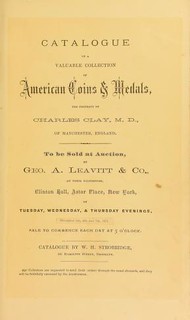 We can trace this piece back to
Strobridge and Woodward's December 1871 sale of the Dr. Charles Clay Collection of Manchester, England. It was offered in that sale not as a fabrication, but as an authentic
example of the NE punch alongside several other Massachusetts silver coins displaying the exact same mark. Believing it to be genuine, Dr. Charles Clay himself suggested that it
"almost proves [Pine Tree coinage] to have been in circulation before the N.E. coins, or that the impression may have been a freak with the old N.E. punch." Held in high
regard, this piece was even featured on the very limited photo plates included with the sale.
We can trace this piece back to
Strobridge and Woodward's December 1871 sale of the Dr. Charles Clay Collection of Manchester, England. It was offered in that sale not as a fabrication, but as an authentic
example of the NE punch alongside several other Massachusetts silver coins displaying the exact same mark. Believing it to be genuine, Dr. Charles Clay himself suggested that it
"almost proves [Pine Tree coinage] to have been in circulation before the N.E. coins, or that the impression may have been a freak with the old N.E. punch." Held in high
regard, this piece was even featured on the very limited photo plates included with the sale.
It was purchased by James Carson Brevoort of Brooklyn, New York for $6.50. Brevoort's collection was later sold by Thomas Elder in November 1925, and this coin is likely that described as "large flan, die broken through date." in lot 1885.

By the middle of the 20th century, the infamy of this piece begins to build among collectors. It is mentioned explicitly by John J. Ford, Jr in his article Untraced Curiosities in the American Colonial Series that appeared in the April-October 1947 issue of Numismatic Review. Ford calls the 1871 Clay sale "notorious" and notes that it was "the talk of early numismatists for many years and contained a large number of extremely questionable colonial coins." Referring to this particular specimen, he regards it as "nothing more than a curiosity" and an example of "careless handling of an imitation N.E. punch."
 It was later featured
in Eric P. Newman's The Secret of the Good Samaritan Shilling (1959), where he exposes dozens of counterfeits or fabrications that had infiltrated the market over the
previous century. Newman suggests that this piece and the others in the Clay sale were from a "dangerous fabricator" and that they were allegedly found in a
"hoarded mass." He also remarks that this piece was already in the Norweb Collection at the time of writing.
It was later featured
in Eric P. Newman's The Secret of the Good Samaritan Shilling (1959), where he exposes dozens of counterfeits or fabrications that had infiltrated the market over the
previous century. Newman suggests that this piece and the others in the Clay sale were from a "dangerous fabricator" and that they were allegedly found in a
"hoarded mass." He also remarks that this piece was already in the Norweb Collection at the time of writing.
 It most recently appeared in our
sale of the legendary Norweb Collection, Part I in October 1987, where we called it a "chronological and logical inconsistency." Even so, it remains an important piece
of numismatic history and colonial Americana. While not contemporary, the countermark seen here adds considerable intrigue and has been the focus of significant scholarship and
study. Advanced collectors will relish the opportunity to add this remarkable Noe-1 to their cabinets.
It most recently appeared in our
sale of the legendary Norweb Collection, Part I in October 1987, where we called it a "chronological and logical inconsistency." Even so, it remains an important piece
of numismatic history and colonial Americana. While not contemporary, the countermark seen here adds considerable intrigue and has been the focus of significant scholarship and
study. Advanced collectors will relish the opportunity to add this remarkable Noe-1 to their cabinets.
To read the complete article, see:
Infamous "NE" Pine Tree Shilling Featured in our November 2019
Baltimore Auction (https://www.stacksbowers.com/News/Pages/Blogs.aspx?ArticleID=pine-tree-shilling-counterstamp)
I've added images of the reference works mentioned, taken from the Newman Numismatic Portal. -Editor
To read the referenced works on the Newman Numismatic Portal, see:
Catalogue of a valuable collection of American coins & medals the property of Charles Clay ...
[12/05/1871-12/07/1871] (https://nnp.wustl.edu/library/auctionlots?AucCoId=29&AuctionId=511194)
Numismatic Review (1947) Labeled as No. 14-16 (Vol. 4, Nos. 2-4), April-October 1947.
(https://nnp.wustl.edu/library/book/534187)
Secret of the Good Samaritan Shilling (https://nnp.wustl.edu/library/book/559016)
The Norweb Collection: Part I
(https://nnp.wustl.edu/library/auctionlots?AucCoId=4&AuctionId=524004)

HISTORY OF CURRENCY COUNTERFEITING
JP Koning passed along this Reserve Bank of Australia article by Richard Finlay and Anny Francis on the history of counterfeiting. Thanks. Here's an excerpt. -Editor

Abstract
The crime of counterfeiting is as old as money itself, and can be targeted at both low- and high-value denominations. In most cases, counterfeiting is motivated by personal gain
but, at times, it has also been used as a political weapon to destabilise rival countries. This article gives a brief history of counterfeiting, with a particular focus on
Australia, highlighting selected incidents through time and the policy responses to them. For source material on Australia, we draw on Reserve Bank archives dating back to the
early 1900s.
Introduction
Historical evidence suggests that, for as long as physical money has existed, it has been counterfeited.[1] The reason to counterfeit – in the distant past and today – is usually
fairly straightforward: the possibility of money for (almost) nothing, offset of course against the likelihood of getting caught and punished. However, the means of counterfeiting
has changed, with rapid technological advances making counterfeiting arguably easier and reducing the amount of time that a currency remains resilient to counterfeiting. As a
result, currency issuers have tended to release new currencies in shortening timespans in order to stay ahead of counterfeiters.
Around 400 BC for instance, Greek coins were commonly counterfeited by covering a less valuable metal with a layer of precious metal (Markowitz 2018). Another method was to make a mould from a relatively low-value genuine copper coin, which was then filled with molten metal to form a counterfeit. The widespread practice of counterfeiting coins led to the rise of official coin testers, who were employed to weigh and cut coins to check the metal at the core.
Coin ‘shaving’ or ‘clipping’ was another commonly observed method of early coin fraud, whereby the edges of silver coins were gradually shaved off and melted down. In 17th century England, for example, the weight of properly minted money had fallen to half the legal standard, while one in 10 British coins was counterfeit (Levenson 2010). To remedy the situation, by mid 1690 all British coins had been recalled and reminted, and Sir Isaac Newton – the warden of the Royal Mint as well as the person who formulated the laws of motion and gravity – was tasked with stopping the situation re-emerging. By the end of 1699 he had successfully identified the lead counterfeiter as William Chaloner, who had produced counterfeits with a face value of £30,000 (worth around A$10 million today). He was ultimately hanged for his crimes.
Early paper banknotes were also counterfeited. Some of the first banknotes to be issued appeared in the Song Dynasty in China towards the end of the 10th century, and were known as ‘jiaozi’ (Von Glahn 2005). Initially jiaozi were issued privately by all manner of entities but, in 1005, the right to issue jiaozi was restricted by the authorities to 16 merchant houses. Complex designs, special colours, signatures, seals and stamps on specially made paper were used to discourage counterfeiters. Those caught counterfeiting faced the death penalty. Despite this, counterfeiting increased over time. This, along with an oversupply of jiaozi, led to inflation and in 1024 the right to print and issue currency was restricted to the government. The officially issued notes ‘expired’ after two years, after which they were redeemed, for a 3 per cent fee. This policy – perhaps the first ‘clean note’ policy in history – was in part aimed at preventing circulating currency from becoming too worn and tattered; having a higher quality of notes should make it easier to distinguish counterfeits from the genuine article. Some aspects of the evolution of the Song Dynasty's approach to note issue – such as moving from multiple issuers to just the government, having increasingly complex banknote designs and implementing a clean note policy – can be seen in modern banknote policy evolution 1,000 years later, including in Australia as discussed below.
JP adds:
Some gems in there like "... I would reiterate my oft expressed opinion that the existing issue of Australian Notes, so far as design and character of work are concerned, are nothing more than what might be termed glorified jam labels"
To read the complete article, see:
A Brief History of Currency Counterfeiting
(https://www.rba.gov.au/publications/bulletin/2019/sep/a-brief-history-of-currency-counterfeiting.html)
THE JOE REDNER POLITICAL NOTE
One of my favorite topics is the work of "money artists" like the late J.S.G. Boggs; another is political slogans on paper money. A browse through eBay this week turned up an item fitting both categories - a political note designed by Boggs and his friend former BEP engraver Tom Hipschen. I ordered one for my collection after reaching out to Craig Whitford for confirmation and advice. Craig is working on a catalog of Boggs' work. -Editor

"This is a privately issued, political/fantasy "banknote." It was commissioned by well-known money artist J. S. G. Boggs, and designed by three other artists. Tom Stebbins did the portrait of local political figure Joe Redner, the back was from an engraving by Thomas Hipschen, famous BEP engraver who did the portrait of Benjamin Franklin on one of the older $100 bill designs, and the note itself designed by Matej Gabris.”
Country: Fun Notes Assorted
Denomination: 1 vote
Price: $10.00
Catalog #: new
Product ID: 17095085
Year: 2016
Grade: UNC (uncirculated)
Other Info: Political note - Joe Redner running for FL senate. Portrait by Tom Stebbins, note designed by Matej Gabris, engraving by former BEP engraver Tom Hipschen; and
commissioned by J. S. G. Boggs. This note has the facsimile signature of all four of these well-known fantasy banknote artists/designers!
Coloration: Gray w/violet underprint; orange.
Depictions: Joe Redner, local FL political figure and club owner, on front; FL Senate building on back. Stebbins and Gabris print.
Note Size: 6 1/8" x 2 5/8"
Watermark: None.
To read the complete eBay lot description, see:
1 VOTE JOE REDNER POLITICAL NOTE STEBBINS & GABRIS; COMMISS. BY J. S. G. BOGGS! (https://www.ebay.com/itm/163864288518)
Craig adds:
This note is definitely connected to Boggs and Hipschen. I'm not sure who the seller is or how they managed to get ahold of a quantity. At $9 and $10 it's truly an entry level bargain for a Boggs item.

Image courtesy Craig Whitford

LOOSE CHANGE: SEPTEMBER 22, 2019
Here are some additional items in the media this week that may be of interest. -Editor
The Most Valuable Post-1950s U.S. Coins
Joshua McMorrow-Hernandez published a piece on CoinWeek about some of the most valuable post-1950s U.S. coins. Here's an excerpt. -Editor
 The recent private
transaction of the ultra-rare 1975 No-S Proof Roosevelt dime for $516,000 USD, coming just a few days after realizing $456,000 during a public sale by Heritage Auctions at the
Long Beach Expo in California, puts into perspective the great importance of modern rare coins. While some collectors and dealers eschew modern clad coins, often going so far as
to dub such coinage as mere “junk”, post-1950s coinage is clearly earning a place in the hearts and minds of more collectors.
The recent private
transaction of the ultra-rare 1975 No-S Proof Roosevelt dime for $516,000 USD, coming just a few days after realizing $456,000 during a public sale by Heritage Auctions at the
Long Beach Expo in California, puts into perspective the great importance of modern rare coins. While some collectors and dealers eschew modern clad coins, often going so far as
to dub such coinage as mere “junk”, post-1950s coinage is clearly earning a place in the hearts and minds of more collectors.
And the proof is in the sales records, as the rarest examples of many modern coins are increasingly charting five- and even six-figure prices. In the decades since the early 1980s, when the only two known 1975 No-S dimes realized impressive five-figure sums of $18,200 and $38,550 during an initial offering by Illinois coin dealer Fred Vollmer, they and other modern coins have made some impressive marketplace showings.
In some cases, a modern coin needn’t even contain an error or unusual variety to score a high price.
To read the complete article, see:
Five More Rare Modern Coins Worth Big Bucks
(https://coinweek.com/modern-coins/five-more-rare-modern-coins-worth-big-bucks/)
Virgil Brand's Coins
Martin Kaplan passed along this CoinsWeekly article on Virgil Brand and his collection, based on the Chicago Coin Club press release from earlier this year. It includes images of some important world coins from Brand's collection. Check it out. -Editor
 To read the complete article, see:
To read the complete article, see:
the Biggest Coin Collection Its Collector and the Hall
of Fame of the Chicago Coin Club/ (https://coinsweekly.com/the-biggest-coin-collection-its-collector-and-the-hall-of-fame-of-the-chicago-coin-club/)
To read the earlier E-Sylum article, see:
CHICAGO INDUCTS VIRGIL BRAND INTO HALL OF FAME (https://www.coinbooks.org/v22/esylum_v22n13a20.html)
The Case of the Coin-Collecting Cop Named Crooks
A policeman who liked coin collecting a little too much is in trouble for taking a suspect's coin from the property room. -Editor
An Indianapolis police lieutenant is disputing criminal charges filed against him Thursday after investigators say he stole a suspect's "lucky gold coin" from the police department's property room.
Crooks, 56, worked as a supervisor in the property room, according to court records, and oversaw other personnel there. The department's property room is where officers store evidence and suspects' personal belongings, such as guns and money.
In an interview with detectives, a civilian supervisor said Crooks was "always looking for coins" in the property room.
Crooks told property room employees to set the coin aside, according to investigators, while he withdrew cash from the bank to replace the value of the coin. He took a $20 bill out of his pocket and traded it.
Officers had seized the coin as part of a drug investigation in July 2018, according to court documents.
A civilian employee told investigators of another instance when Crooks traded a coin for cash.
According to investigators, Crooks once told her: "If you find any coins in the count, don't forget me."
Um, it's not the "money" room or the "cash" room, it's the Property Room. Everything in it is the property of someone else. As a collector I've certainly asked cashiers to exchange scarce coins for a cash equivalent, but switching a double eagle for a $20 bill in this case is property theft, even if the clerk on duty is complicit. Weird. -Editor
To read the complete article, see:
IMPD officer stole 'lucky gold
coin' from property room, investigators say
(https://www.indystar.com/story/news/crime/2019/09/20/impd-officer-stole-lucky-gold-coin-property-room-investigators-say/2384899001/)
FEATURED WEB SITE: CANADIAN ASSOCIATION FOR NUMISMATIC EDUCATION
This week's Featured Web Site is the Canadian Association for Numismatic Education.Our Mandate
• To educate the public about numismatics on the study of coins, currency, medals, tokens, paper money, and related objects primarily from Canada, but also including other cultures, past and present, through the provision of educational programs and activities;
• To conduct research about primarily Canadian numismatics and to communicate the results therefrom to interested individuals, groups, organizations, academics, and governments in order to educate the public about numismatics; and
• To give scholarships and bursaries for the study and research of numismatics.

https://www.cafne.ca/

